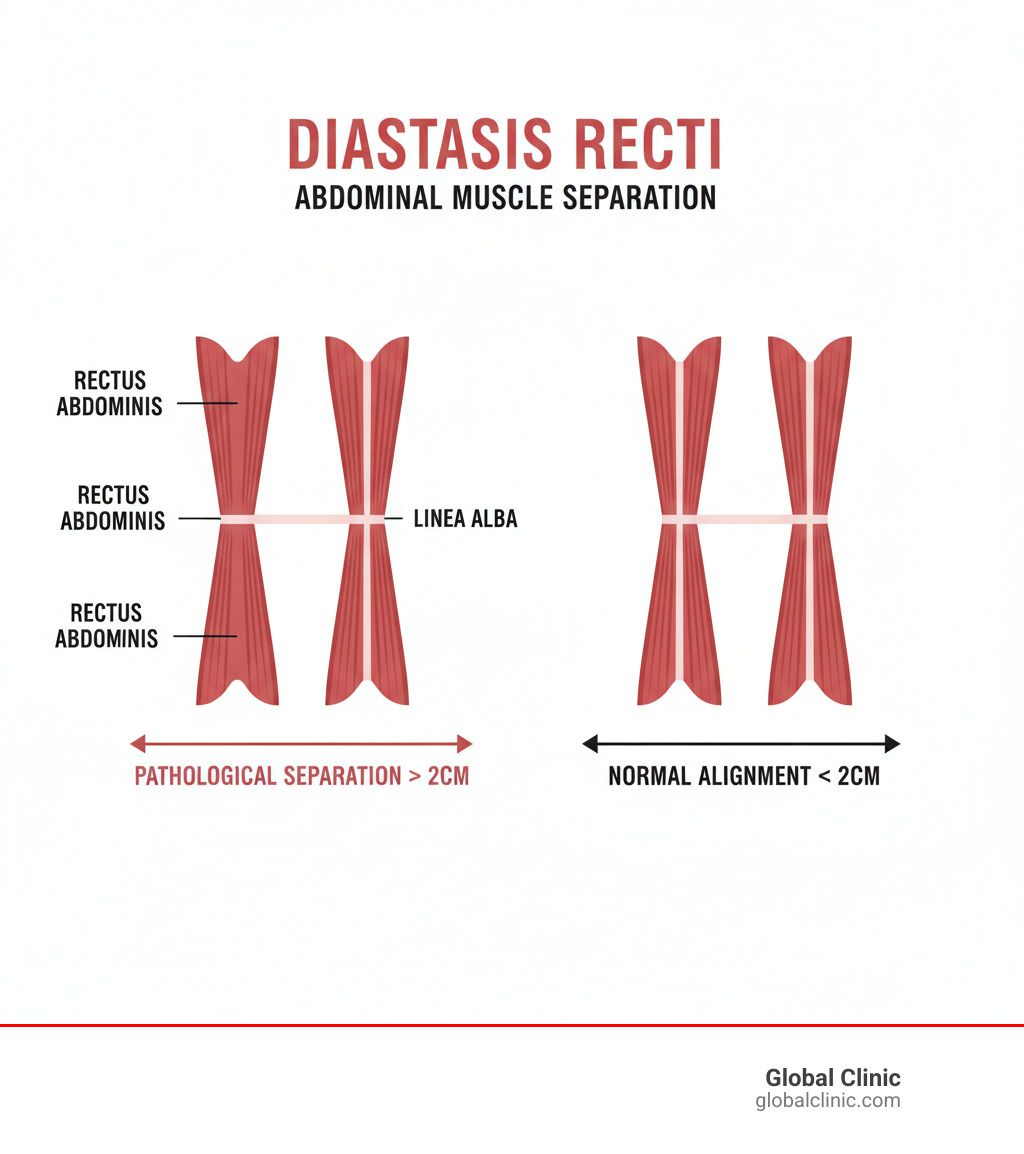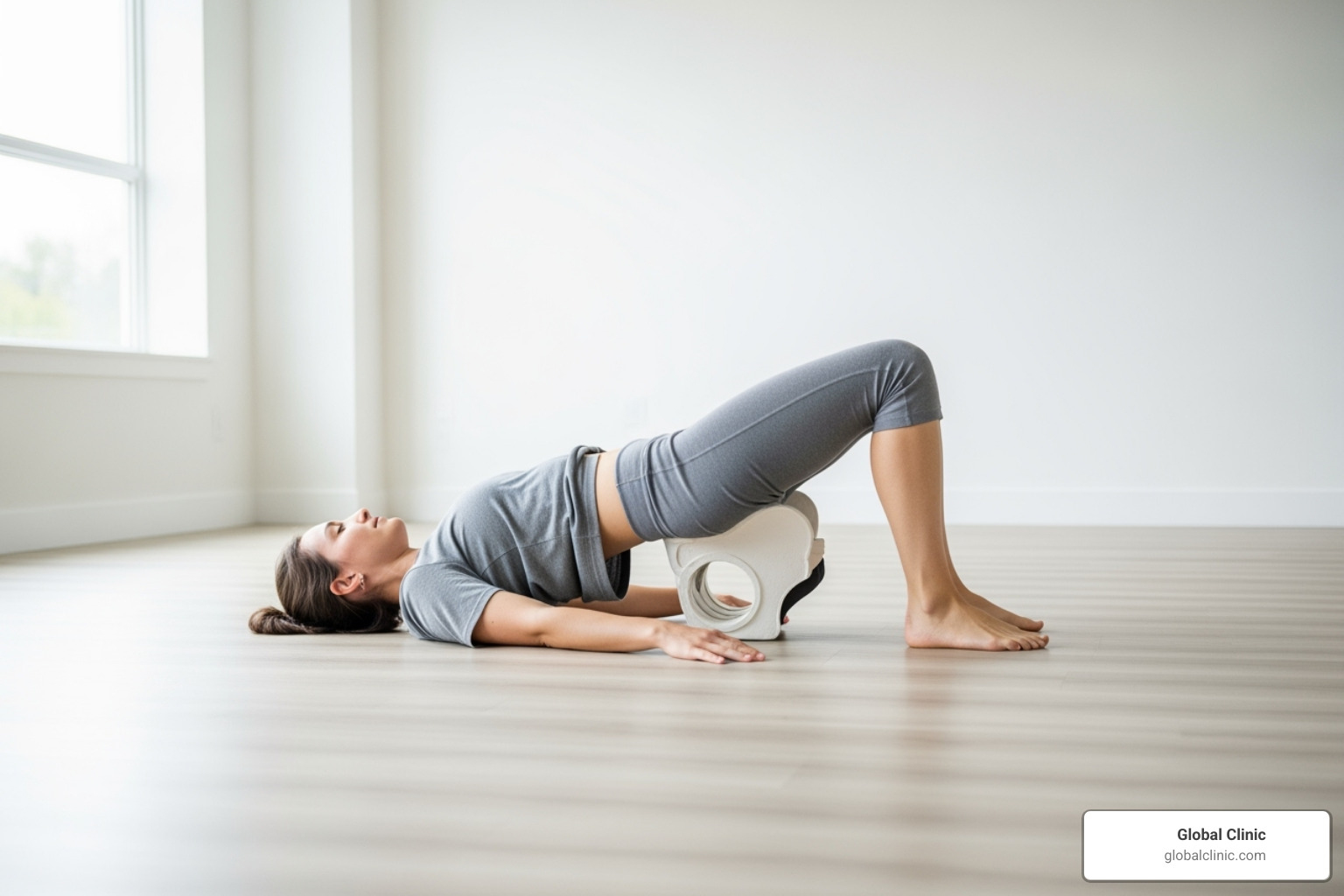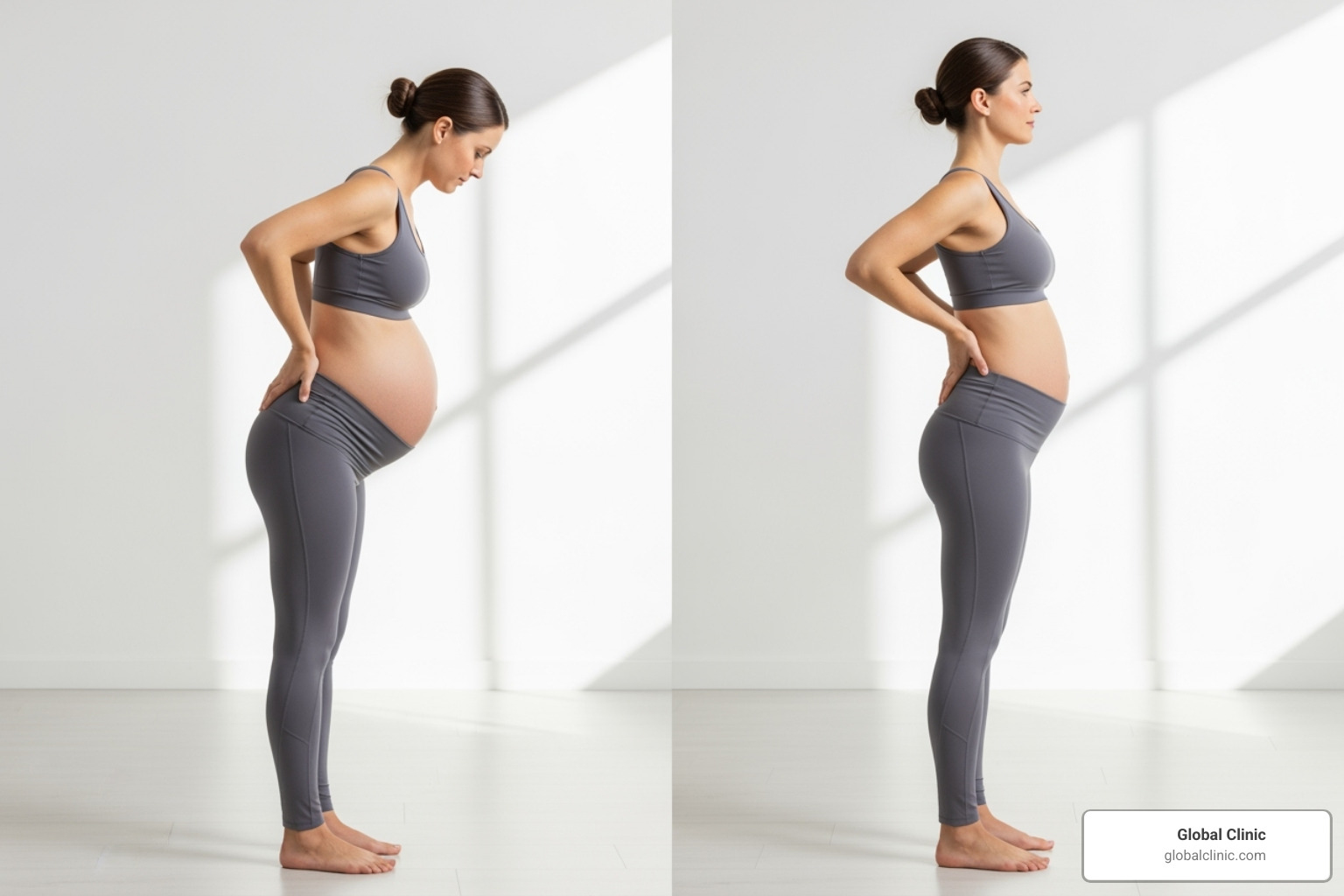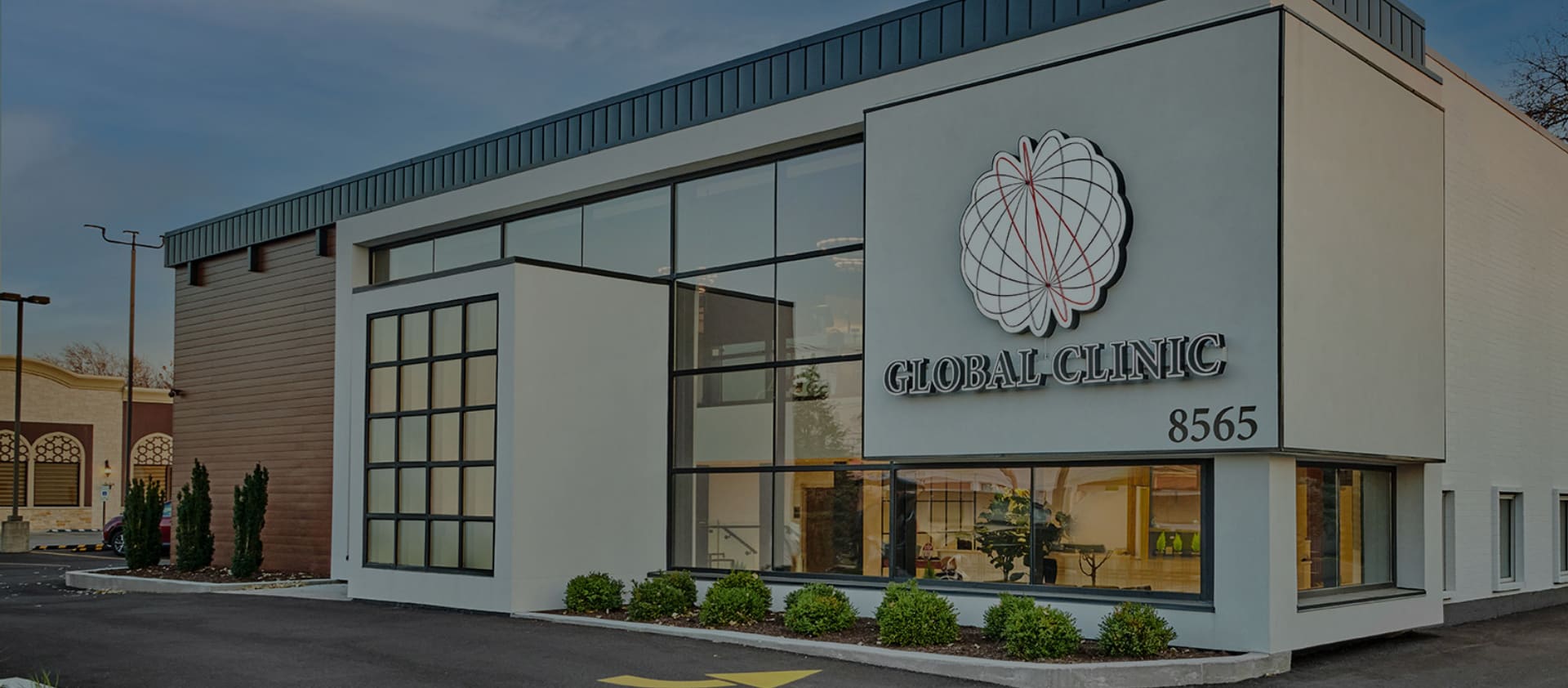Understanding Abdominal Separation and Your Path to Recovery
Diastasis recti therapies offer both non-surgical and surgical paths to heal the separation of abdominal muscles. If you’ve noticed a persistent bulge down the center of your abdomen after pregnancy or significant weight changes, you may have diastasis recti. This condition, where the “six-pack” muscles separate, affects up to 60% of pregnant women.
The good news is that diastasis recti is treatable. Targeted therapies can significantly improve core strength and abdominal appearance. You don’t have to accept chronic back pain, pelvic floor dysfunction, or a “mommy pooch” as your new normal. However, traditional exercises like crunches can worsen the condition, making a professional approach essential.
I’m Ana Vinikov, Practice Manager at Global Clinic. For over 20 years, our team in Northern Chicago has helped patients recover from postpartum abdominal separation and other musculoskeletal conditions. Our multidisciplinary diastasis recti therapies combine Physical Therapy and Chiropractic Care to address the root cause of core weakness.
Primary treatment options include:
Non-Surgical Therapies:
- Physiotherapy and specialized exercises
- Body mechanics and posture training
- Abdominal support garments
- Core-focused breathing exercises
Surgical Options:
- Abdominoplasty (tummy tuck)
- Rectus plication (muscle repair)
- Laparoscopic repair
Surgery is typically a secondary option, considered only after conservative treatments have been tried for several months or if a hernia is present.

Simple diastasis recti therapies word guide:
Understanding Diastasis Recti: Signs, Causes, and Diagnosis
Before exploring diastasis recti therapies, it’s important to understand the condition. Your rectus abdominis muscles (the “six-pack”) are held together by a connective tissue called the linea alba. Diastasis recti occurs when this tissue stretches and thins, causing the muscles to separate. A gap of more than 2 centimeters (about two finger-widths) is considered significant and can lead to functional problems.
Causes and Risk Factors:
- Pregnancy: The most common cause, due to internal pressure and hormonal changes. Up to 66% of women experience it in the third trimester, and for 30-60%, it persists after delivery.
- Obesity: Excess abdominal fat creates constant outward pressure.
- Chronic Straining: Improper heavy lifting, persistent coughing, or constipation can stretch the linea alba over time.
- Multiple Pregnancies: Risk increases with each pregnancy.
- Age and Genetics: Natural changes in tissue elasticity and a predisposition to weaker connective tissue can play a role.
Common Signs and Symptoms:
- A visible bulge, ridge, or “coning” down the center of the abdomen, especially when engaging the core.
- Lower back pain due to a weakened core. Addressing back pain with physical therapy is often a key part of treatment, especially for postpartum back pain.
- Poor posture as the body compensates for a lack of abdominal support.
- Pelvic floor dysfunction, as the core and pelvic floor are an integrated system. This can lead to urinary incontinence, bowel leakage, or pelvic organ prolapse.
- Constipation from an inability to generate effective abdominal pressure.
How to Self-Diagnose Abdominal Separation
You can perform a simple check at home, but it doesn’t replace a professional assessment.

- Lie on your back with knees bent and feet flat on the floor.
- Place one hand on your belly with fingertips just above your navel.
- Gently lift your head and shoulders off the floor in a mini-crunch.
- Press your fingertips into your midline. Feel for a gap between the muscle bands and note how many fingers fit. Also, pay attention to the tension of the tissue—is it soft or firm?
- Repeat this check at, and below, your belly button.
A gap of two or more fingers warrants a professional evaluation.
Professional Diagnosis and When to Seek Help
A physical therapist can accurately measure the width and depth of the separation and assess your core function. In some cases, ultrasound imaging may be used. It’s crucial to differentiate diastasis recti from a hernia, which is a hole in the muscle wall rather than a stretching.
| Feature | Diastasis Recti | Umbilical Hernia |
|---|---|---|
| Definition | Stretching/thinning of linea alba | Hole/defect in the abdominal wall |
| Appearance | Midline ridge, worsens with core engagement | Localized bulge, often near the navel |
| Pain | Not inherently painful, but can have associated back pain | Can be painful, especially with straining |
| Tissue Integrity | Connective tissue is stretched but intact | A distinct hole in the fascial layer |
| Complications | Back pain, pelvic floor dysfunction | Bowel obstruction, strangulation (medical emergency) |
See a provider if you have a gap wider than 2 cm, experience pain or functional issues, or are unsure about your self-test.
Can Men Get Diastasis Recti?
Yes, men can develop diastasis recti. It’s less common and usually results from chronically increased abdominal pressure due to improper weightlifting, yo-yo dieting, or obesity. Symptoms are similar to those in women, and the same conservative diastasis recti therapies are effective, focusing on physiotherapy and targeted exercises.
The Foundation of Healing: Non-Surgical Diastasis Recti Therapies
For most people, surgery is not the first answer for diastasis recti. Conservative treatment centered on physiotherapy and lifestyle changes can make a remarkable difference in core strength and symptom reduction. The goal is functional improvement: lifting your kids without back pain, sneezing without leaking, and feeling confident in your body’s strength.
Patient education is key. Understanding how your deep core muscles work together empowers you to become an active participant in your recovery. A scientific research on postpartum exercise study showed that targeted exercise programs effectively reduce muscle separation and improve quality of life.
The Role of Physiotherapy in Diastasis Recti Therapies
Specialized physiotherapy is the gold standard for treating diastasis recti. A trained therapist understands the core as an intricate system—the “inner unit”—composed of four key muscles:
- Transverse abdominis (TVA): Your deepest ab muscle, acting like a natural corset.
- Diaphragm: The “lid” of your core, managing pressure.
- Multifidus: Small but powerful spinal stabilizers.
- Pelvic floor: The supportive base of the core.
These systems are deeply connected; over 70% of women with diastasis recti also have difficulty contracting their pelvic floor. This is why our approach at Global Clinic integrates Pelvic Floor Physical Therapy. Our therapists create individualized programs to create functional tension in the linea alba, allowing it to properly support your core.
Essential Exercises: A Core Component of Diastasis Recti Therapies
Effective diastasis recti therapies focus on activating deep core muscles without creating harmful outward pressure.

Recommended Exercises:
- Pelvic Tilts: Lie on your back, knees bent. Tighten your abs and gently press your lower back into the floor. Hold, then relax. Progress by adding heel slides while holding the tilt.
- Transverse Abdominis (TVA) Contractions: Lie on your back, knees bent. As you exhale, gently draw your belly button toward your spine. Hold for 6 seconds while breathing, then release.
- Diaphragmatic Breathing: Lie down with one hand on your chest and one on your belly. Breathe in through your nose, letting your belly rise. Exhale slowly through pursed lips as your belly flattens.
- Glute Bridges: Lie on your back, knees bent. Squeeze your glutes and lift your hips to form a straight line from shoulders to knees. Lower slowly.
- Standing Wall Planks: Stand facing a wall, hands flat against it. Step your feet back, keeping your body in a straight line and your core engaged. Hold for 3-5 seconds.
Exercises to Avoid:
- Traditional crunches and sit-ups.
- Unmodified planks and push-ups (if they cause abdominal “coning”).
- Heavy lifting while holding your breath.
Supportive Measures and Lifestyle Adjustments
Your daily habits are just as important as your exercises.
- Abdominal Binders: These provide temporary support and can be helpful in the early postpartum weeks, but they are not a long-term solution. They should complement, not replace, your exercise program.
- Posture: Stand tall with shoulders back and ribs stacked over your hips. Good posture reduces strain on your healing abdominal wall.

- Proper Body Mechanics: Use the “log roll” technique to get out of bed: roll to your side, then use your arms to push up. When lifting, bend at your knees, keep the object close to your body, and exhale on exertion. Avoid twisting while lifting.
Advanced Options: When Is Surgery the Right Path?
Sometimes, conservative diastasis recti therapies are not enough. Surgery may be considered if you’ve completed 2-6 months of dedicated physiotherapy without achieving the functional improvement you need. This isn’t a failure, but a reality for some severe or complex cases.
Key indicators for considering surgery include:
- Persistent functional issues: Chronic back pain or severe pelvic floor dysfunction that impacts your quality of life.
- Inability to generate core strength: Despite consistent effort, you cannot effectively stabilize your core for daily movements.
- A severe separation: A very wide or deep gap with poor tissue tension.
- A concomitant hernia: An actual hole in the abdominal wall that requires surgical repair.
Most surgeons recommend waiting until you are finished having children before undergoing repair, as a future pregnancy can cause the diastasis to recur.
Surgical Options:
- Abdominoplasty (“Tummy Tuck”): A comprehensive procedure that repairs the muscles, removes excess skin and fat, and repositions the navel. It addresses both functional and cosmetic concerns.
- Rectus Plication: A procedure focused solely on stitching the separated muscles back together. It can be done alone or as part of an abdominoplasty.
- Laparoscopic or Robotic-Assisted Repair: A less invasive approach where the surgeon makes small incisions and uses a camera and specialized instruments to repair the separation. This may lead to smaller scars and a faster recovery.
Recovery from surgery requires a significant period of rest and limited activity. You will likely wear a compression garment and have restrictions on lifting and exercise for at least 6-8 weeks. Post-surgical physiotherapy is crucial for safely rebuilding core strength and ensuring long-term success. At Global Clinic, our physical therapists work with your surgical team to create a rehabilitation program that respects your healing timeline while restoring function.
Your Journey to Recovery: Prevention, Timelines, and Long-Term Health
Recovery from diastasis recti is a journey. Understanding the timeline and long-term outlook can help you steer it successfully.
Preventative Measures:
While not all cases are preventable, certain strategies can reduce your risk or severity:
- Safe pregnancy exercises: Strengthen your core without putting excessive pressure on the linea alba.
- Healthy weight gain: Gaining weight within recommended guidelines reduces strain on the abdominal wall.
- Proper body mechanics: Using techniques like log rolling and safe lifting protects your core.
- Holistic support: Approaches like those in our Prenatal Chiropractic Care: Complete Guide can help maintain alignment and support core function.
Typical Recovery Timeline:
Your body begins healing immediately after birth, and many mild cases resolve within the first 8 weeks postpartum. However, for many, the separation persists. Statistics show that roughly 45% of women still have diastasis recti six months postpartum.
This is where active intervention with diastasis recti therapies makes a difference. Research shows that consistent deep core exercises (e.g., 3 times a week for 8 weeks) can significantly improve the separation and quality of life. While some people see improvement in weeks, others may need several months. The encouraging news is that it’s never too late to improve, and we’ve helped women at Global Clinic achieve meaningful results years after childbirth.
Long-Term Implications:
If left untreated, diastasis recti can lead to persistent issues that impact quality of life:
- Chronic lower back pain from a poorly supported spine.
- Pelvic floor dysfunction, including incontinence or pelvic organ prolapse.
- Digestive issues or constipation.
- Increased risk of a hernia due to the weakened abdominal wall.
Recurrence is possible, especially with subsequent pregnancies. This highlights the importance of continued core maintenance. The exercises and body mechanics you learn during recovery should become part of your long-term fitness routine to maintain abdominal health. At Global Clinic, we equip you with the knowledge and tools for lifelong core wellness.
Frequently Asked Questions about Healing Abdominal Separation
At Global Clinic, we often hear the following questions about recovery from abdominal separation.
How long does it take to fix diastasis recti?
There is no single timeline, as recovery depends on several factors:
- Severity of Separation: A wider or deeper gap naturally takes longer to improve.
- Consistency: Diligent, correct, and regular exercise is the most significant factor you can control.
- Individual Factors: Age, genetics, and overall health influence your body’s response to diastasis recti therapies.
Many mild cases resolve spontaneously within 8 weeks postpartum. For more significant separations, a targeted physiotherapy program often yields noticeable improvements in strength and function within 8-12 weeks. Achieving maximal improvement can take several months to a year. However, it is never too late to start; meaningful progress can be made even years after childbirth.
Can diastasis recti cause permanent damage?
Diastasis recti itself is not considered “permanent damage,” as the tissues are stretched, not irreversibly destroyed. However, if left untreated, it can lead to persistent and chronic functional problems that significantly impact your quality of life.
Potential long-term complications of untreated diastasis recti include:
- Chronic back pain due to lack of core support.
- Pelvic organ prolapse from increased downward pressure.
- Urinary incontinence, as over 70% of women with diastasis recti have impaired pelvic floor function.
- Increased risk of hernia development in the weakened abdominal wall.
The good news is that these functional consequences can be significantly improved or resolved with appropriate diastasis recti therapies, even if you’ve been experiencing them for years.
Will my stomach ever look the same after diastasis recti?
This is a common and important question. It’s best to separate functional recovery from aesthetic results.
-
Functional Improvement: This is highly achievable. Targeted physiotherapy is very effective at restoring core strength, reducing the abdominal bulge, and allowing you to return to daily activities without pain or dysfunction.
-
Aesthetic Appearance: This depends on factors beyond muscle tone, primarily skin elasticity. Pregnancy stretches the skin, and its ability to bounce back is influenced by genetics, age, and the degree of stretching. Exercise can strengthen the underlying muscles but cannot remove excess, stretched skin.
For those who have achieved full functional recovery but remain concerned about excess skin, surgical options like an abdominoplasty (tummy tuck) can address these cosmetic aspects. At Global Clinic, our primary goal is to help you build a strong, functional core that supports a healthy, active life. The aesthetic improvements that follow are often a welcome bonus.
Take the Next Step Towards a Stronger Core
If you’ve read this far, you know that diastasis recti is common, treatable, and not something you have to live with. You don’t have to accept chronic discomfort or a weakened core as your new reality.
Knowledge is the first step, but expert guidance transforms recovery. At Global Clinic, our team of physical therapists and chiropractors has spent over 20 years helping people in Northern Chicago reclaim their core strength. We create comprehensive, personalized diastasis recti therapies that address the root cause of your condition, including any related back pain or pelvic floor dysfunction.
Our state-of-the-art facility serves communities throughout Northern Chicago, including Arlington Heights, Barrington, Chicago, Crystal Lake, and Des Plaines. Whether you’re a new mom or have been living with abdominal separation for years, we are here to help you build the strong, functional core you deserve.
Don’t let diastasis recti keep you from living a full, active life. Take the next step.
Begin your recovery with Pelvic Floor Physical Therapy and find what personalized, expert care can do for your core strength and overall well-being. Your journey to a stronger you starts here.


